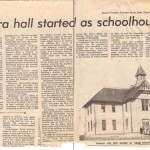Record-Courier, Ravenna-Kent, Ohio, Thursday, October 19, 1978, page 9
By LIZ FLYNN
AURORA—No one knows for certain how long the stately white building now known as Aurora City Hall has been at its present location on Ohio 43, but some Aurorans speculate it is 100 years old or older.
The building has been a landmark for Aurorans throughout the years. Prior to becoming a city hall and police station, it was used as a school house from many years as well as the meeting place for the Masonic Lodge, the site of exciting boxing matches, antique auctions, dances, movies, concerts by the Brass and Reed Band, theatrical performances and just about anything for which anyone needed to use the building.
There appears to be no definite record when the building was actually constructed. Rumors that the building was moved to its present site from another location could not be substantiated by several “old timers” from Aurora.
However, an 1874 atlas shows a school building at the location of the present city hall, but an 1880 tax map does not show the building there. The next current tax map, on record at the Portage County Courthouse dated 1890 does show the school building at the current site.
Aurora’s oldest resident, Johnny McDonald, 90, of 224 East Garfield Rd. used to have minutes from a Church in Aurora trustee meeting dated 1871, which states that the trustees held their first meeting in the new school. The church is located next door to city hall and McDonald believes the minutes were referring to the present city hall building.
McDonald loaned those minutes to some area residents and never saw them again. They may be the only definite record of when the building was actually built.
However, McDonald’s sharp memory has provided the Aurora Historical Society with detailed information about city hall as well as other information on Aurora’s heritage.
McDonald went to school in the present city hall building back in 1895. At that time the two-room building, with a staff of four teachers was already beginning to show some aging, according to McDonald. In 1898 the school became the first consolidated school in Portage County, combining seven one-room school houses in Aurora and adding five years of schooling for Aurora’s children.
The stairway banister, the same one that is in the building today, was a favorite spot for children to slide down as they made their exit from the building.
A sink used to sit at the bottom of the stairs, but there was no running water in the building, according to McDonald.
In addition, records show that a huge bell used to hang in the building’s steeple. For some unknown reason the bell was removed many years ago and no one knows what happened to it.
McDonald believes the bell was taken out shortly after a fire broke out in the upper story of the building in the early 1900s. The Masonic Lodge was holding a meeting at the time the fire occurred and they were able to save the building by putting the fire out with buckets of water.
One of McDonald’s fondest memories of attending school there, was when the first horseless carriage came through Aurora.
According to McDonald, the school had received a telephone call from Streetsboro saying that the vehicle had just made its way through town and was heading for Aurora. The 5 m.p.h. vehicle took an hour to get to Aurora, but the entire student body and faculty was standing in front of the building waving and cheering to the car as it drove past the school.
In 1896 the school underwent an expansion and students were moved from the existing building to a temporary school across the street where the Pioneer Tavern now stands, according to McDonald.
It took one year for the work to be completed and the students moved into the remodeled building after spending a cold winter in the temporary facilities where they “near froze to death,” noted McDonald.
In 1912 the school was moved to the location of Village School on Ohio 82 and the township trustees took over ownership of the building and made it a town hall.
Shortly after the trustees purchased the building they had the stage moved from the old town hall building (which was located where the fire department presently exists, one building away from the city hall) to the rear of the city hall building.
The stage now houses the mayor and clerk of council’s offices. The original graffiti on the stage wall can still be seen in the clerk’s office today.
In later years, the police station moved into the building. And as the city grew, the police and city hall offices expanded so much that they now occupy the entire building.
Caption: Historic City Hall started as village school house.

